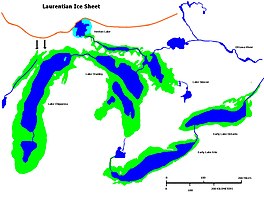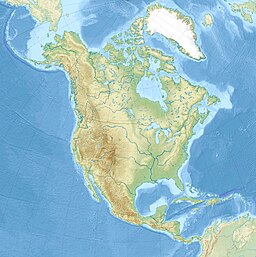| Lake Stanley | |
|---|---|
 Glacial Lakes Chippewa, Stanley, Early Erie and Early Ontario. Low level lake stages during the end of the Wisconsin Glacial era in North America. Based on Larsen map, 1987. | |
| Location | North America |
| Group | Great Lakes |
| Coordinates | 44°48′N 82°24′W / 44.8°N 82.4°W |
| Lake type | former lake |
| Etymology | George M. Stanley |
| Primary inflows | Lake Chippewa basin |
| Primary outflows | French River (Ontario) |
| Basin countries | Canada United States |
| Max. length | 241 mi (388 km) |
| Max. width | 57 mi (92 km) |
| Residence time | 1850 years in existence |
| Surface elevation | 476 ft (145 m)[1] |
| References | Lewis CFM, Cameron GDM, Anderson TW, Heil CW Jr, Gareau PL. 2012. Lake levels in the Erie Basin of the Laurentian Great Lakes. Journal of Paleolimnology 47:493-511. |

Lake Stanley, also called the Stanley unconformity, is a postglacial freshwater lake that occupied part of what is now the basin of Lake Huron during a hydrologically significant period from 10,000 years Before Present (B.P.). The lake’s surface level was approximately 70 meters below the current lake’s water surface.[2]
The lake, although geographically smaller than the current Lake Huron, was fed from a large Lake Chippewa watershed that included the basin of what is now Lake Michigan. During this period, the water from Lake Stanley drained through an outlet or outlets adjacent to what is now North Bay, Ontario.[3]
- ^ Holcombe TL, Taylor LA, Reid DF, Warren JS, Vincent PA, Herdendorf CE. 2003. Revised Lake Erie postglacial lake level history based on new detailed bathymetry. Journal of Great Lakes Research *29:681-704.
- ^ Lewis, C.F.M.; Heil Jr., C.W. (13 January 2007). "The Stanley unconformity in Lake Huron basin: evidence for a climate-driven closed lowstand about 7900 BP". Journal of Paleolimnology. 37: 435–452. doi:10.1007/s10933-006-9049-y. S2CID 129166066.
- ^
Larsen, Curtis E. (1987). "Geological History of Glacial Lake Algonquin and the Upper Great Lakes [U.S. Geological Survey Bulletin No. 1801]" (PDF). pubs.usgs.gov. United States Geological Survey. Retrieved December 23, 2019.
At the Mackinac Straits, where a fluvially eroded channel joins the lake basins (page 14)
